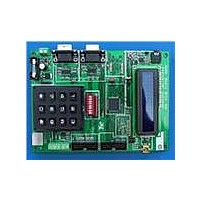STEVAL-ILL024V1 STMicroelectronics, STEVAL-ILL024V1 Datasheet - Page 13

STEVAL-ILL024V1
Manufacturer Part Number
STEVAL-ILL024V1
Description
LED BOARD FOR STM32 STP16DP05
Manufacturer
STMicroelectronics
Specifications of STEVAL-ILL024V1
Design Resources
STEVAL-ILL024V1 BOM STEVAL-ILL024V1 Schematic
Current - Output / Channel
100mA
Outputs And Type
16, Non-Isolated
Voltage - Output
20V
Features
Short-Circuit Protection
Voltage - Input
3 ~ 5.5V
Utilized Ic / Part
STM32F103VB, STP16DP05
Description/function
LED Display Demo System Control Unit
Product
Display Modules
For Use With
497-9087 - LED MATRIX DISPLAY PANEL
Lead Free Status / RoHS Status
Lead free / RoHS Compliant
For Use With/related Products
STM32F103VB
Other names
497-9091
UM0767
3.3
Multiple control and display unit configuration
In this configuration there are multiple control units and multiple display panels. One control
unit should be the master and the others slaves. By default, the system comes with one
master and one display panel.
The steps to operate the system in this configuration are listed below:
●
●
●
●
If needed, the display panels can be cascaded in series to create a longer display. To
cascade the display panels connect a 20-pin flat-ribbon cable from the J3 jumper (output) of
the first panel to the J1 jumper (input) of the second panel.
for cascading the display panels. Similarly, connect the FRC cable from the J3 jumper
(output) of the second panel to the J1 jumper (input) of the third panel and so on to create a
longer display. Up to 8 such display panels can be cascaded in series.
●
●
●
●
●
●
●
●
Step 1: configure one control unit as the master and the other control units as slaves,
as explained in
Step 2: configure the address of the slave boards using the on-board DIP switches, as
explained in
Step 3: connect the PS2 keyboard to the master control unit.
Step 4: connect the display panels to each slave control unit using a 20-pin flat-ribbon
cable. Insert the cable into the 10 x 2 header (Ext.Con) present on the slave at one side
and in the J1 header (input) on the display panel at the other side.
Step 5: connect the master and the slave control units using a twisted pair cable.
Ensure that RS485+ at master is connected to RS485+ at slave and RS485- at master
is connected to RS485- at slave. Connections are made at the J18 screw type
connector.
Step 6: power-up the master control unit, the slave control units and the display panels
using DC power supplies. Please ensure that when cascading the display panels,
power should be individually supplied at the J5 screw type connector on each display
panel.
Step 7: the LCD on the master and slave control unit shows “Press “#” to enter
ConfigurationMod”. This is displayed for 4 seconds. If the master and slave boards are
already configured in Step 1, don't press “#”, the board then resumes functioning after
4 seconds.
Step 8: the master control unit starts the demo showing “LED Matrix Demo” and the
slave control unit starts showing its own address. (The address is configured using on-
board switches).
Step 9: the display at master shows 4 options:
–
–
–
–
Step 10: press F1, F2, F3, or F6 on the keyboard to select one of the above mentioned
modes.
Step 11: based on which of the keys listed above is pressed, the system enters into the
chosen mode. Operation in each mode is explained in
Step 12: the master board LCD asks for the address of the slave control unit in order to
configure the display unit.
Press F1 For PC - UART Comm
Press F2 For GPS data display
Press F3 for typing data
Press F6 for demo mode
Figure 8
Section
Section
shows the RS485 connection topology.
2.1.1.
2.1.2.
Doc ID 16147 Rev 1
Figure 6
Section
4.
shows the connections
System configuration
13/30





















